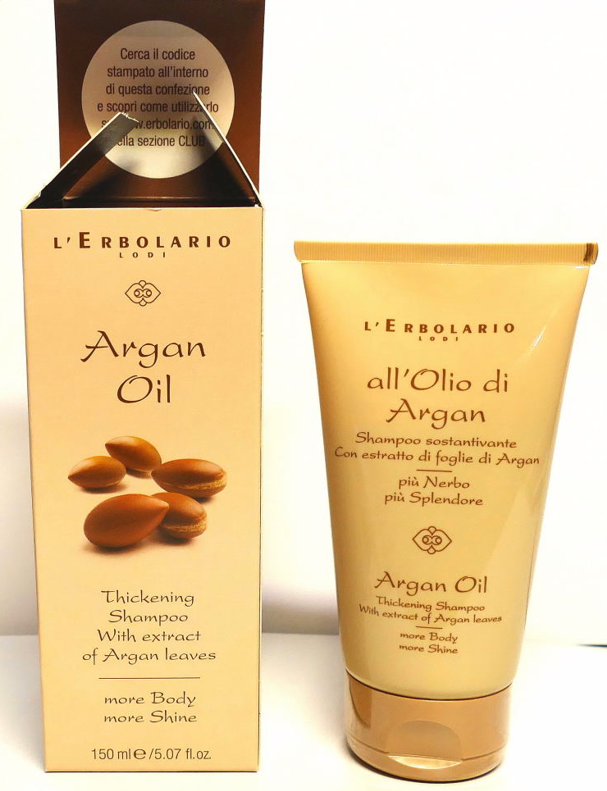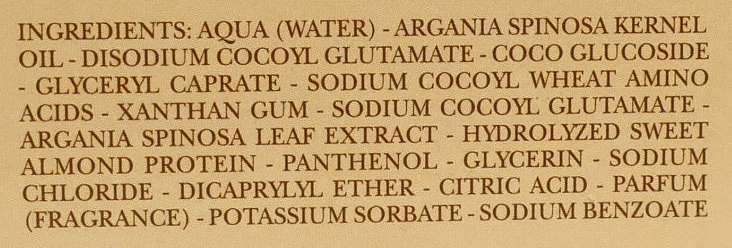Review L'Erbolario Argan oil Thickening Shampoo 200 ml

What it is for:

Special features:

Ingredients:

Let us examine the most significant ingredients in order of quantity as indicated on the label. I provide a brief summary for reasons of space. For the full text, studies and bibliography, just click on the ingredient and, if you want to go deeper, it is perhaps a little complex reading because these are scientific studies, but it clarifies the ingredient/health relationship.
Argania spinosa kernel oil is Argan oil, extracted from the kernel of the Argania spinosa tree generally obtained by cold pressing. It is used in cosmetic products for its nourishing, moisturising, skin-protective and hair-protective properties conferred by saponins, polyphenols and tocopherols, which also have the activity of relaxing and repairing the stratum corneum.
Disodium Cocoyl Glutamate, disodium salt of L-glutamic acid. Surfactant, anionic cleaning agent acting as a foaming agent.
Coco Glucoside is a chemical compound, derived from plants, usually mainly from coconut. Surfactant used as a foaming agent and emulsifier. It cleanses the hair and increases combability.
Glyceryl caprate, monoester lipid of glycerine and capric acid. Surfactant with detergent function, non-ionic emulsifier. solubiliser, absorption promoter, antimicrobial, moisturiser, refractory agent.
Sodium cocoyl wheat amino acids is a derivative of coconut acid and wheat protein. Cleansing surfactant, conditioning agent for skin and hair.
Xanthan gum a thickening polysaccharide or rheology modifier to stabilise the emulsion. As a humectant, it improves the water absorption of the skin by moisturising and lubricating.
Sodium Cocoyl Glutamate a product obtained from vegetable sources such as oils (coconut oil) and sugar. Surfactant, an anionic cleaning agent acting as a foaming agent.
Argania spinosa leaf extract. Water-soluble antioxidant. It is used in cosmetic products for its nourishing, moisturising, skin-protective and hair-protective properties, conferred by saponins, polyphenols and tocopherols, which also have activities to stretch and repair the stratum corneum.
Hydrolized sweet almond protein. Skin and hair conditioner, protective agent for hair, film-former. Discreet antistatic capacity.
Panthenol is derived directly from vitamin B5 or pantothenic acid. It promotes lipid synthesis and improves the skin's barrier function. It has favourable and lasting effects on barrier function and repair as well as on skin hydration without negatively influencing bacterial viability in the skin microflora.
Glycerin, trivalent, hygroscopic alcohol. Its water solubility, hygroscopicity and hydrophilicity characteristics give glycerine humectant and moisturising capabilities that are of great importance in most topical cosmetic applications.
Sodium chloride is the common salt. In cosmetics, sodium chloride functions to increase the moisturising effectiveness of ageing skin, is a thickener in shampoos and conditioners, but is also a co-factor in the eye irritation experienced with most shampoos and can cause dryness and itching of the scalp.
Dicaprylyl ether is a chemical compound that can be obtained from palm oil and coconut oil. Used as a moisturising emollient to soften the skin, it enables the formulation of silicon oil-free body care products to improve tactile and sensory sensation.
Citric acid is obtained from lemon juice (from whose Latin name citrus is derived), other fruits, beet juice and other vegetables. Acidity regulator (pH), preservative, antioxidant.
Parfum Used as a synthetic fragrance, Parfum does not have a list of its ingredients as each manufacturer produces it at the customer's request. Therefore, it is not known whether there are chemical compounds within it that can create sensitisation.
Potassium sorbate is the potassium salt of sorbic acid. It is used in detergents, shampoos, creams and body and facial products to prevent mould growth and prolong product life.
Sodium benzoate sodium salt of benzoic acid. It is used in body care products, facial care products for its anti-bacterial and anti-fungal properties.
Conclusions
An excellent product with ingredients aimed at achieving the purpose stated on the label: repairing and strengthening hair. All ingredients are of excellent quality and have no health contraindications. The only drawback is the ingredient Parfum, used as a synthetic fragrance, the composition of which even the manufacturers are believed not to know.
![]() L'Erbolario Argan oil Thickening Shampoo 200 ml
L'Erbolario Argan oil Thickening Shampoo 200 ml 





